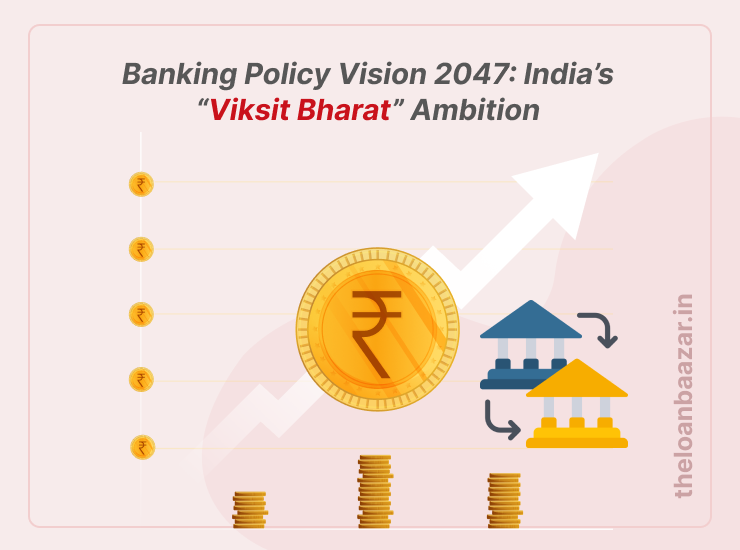India has set an ambitious economic and financial roadmap under the “Viksit Bharat 2047” vision. As part of this, the PSB Manthan 2025 initiative lays the foundation for transforming public sector banks (PSBs) into global financial powerhouses. The ultimate target: ensuring at least two Indian PSBs rank among the world’s top 20 banks by assets by 2047.
This vision aligns with India’s broader aspiration of becoming a developed nation by 2047—the centenary of Independence. To achieve this, PSBs are expected to evolve through technology adoption, structural reforms, financial inclusion, and global competitiveness.
Why PSBs Are Central to “Viksit Bharat 2047”
Public Sector Banks (PSBs) are the backbone of India’s financial system, holding a dominant share in deposits, advances, and rural outreach. Their role in financial inclusion, infrastructure funding, and SME support makes them critical to India’s economic growth story.
The government’s vision is not just to strengthen PSBs for domestic needs but also to position them as global leaders competing with major international banks.
Key Goals of PSB Manthan 2025
The PSB Manthan 2025 roadmap outlines near-term strategies that will set the stage for long-term global ambitions. Some of the core goals include:
-
Strengthening Balance Sheets: Improving asset quality, reducing NPAs, and ensuring adequate capital buffers.
-
Technology Transformation: Embracing AI, blockchain, and digital platforms for efficiency and global competitiveness.
-
Structural Reforms: Considering mergers, partnerships, and governance reforms to scale operations.
-
Global Expansion: Encouraging Indian PSBs to expand branches, subsidiaries, and operations internationally.
-
Customer-Centric Innovation: Driving financial inclusion while offering digital-first solutions to retain competitiveness.
India’s Ambition: Two PSBs in Top 20 Global Banks by 2047
Globally, the top 20 banks by assets are dominated by Chinese, U.S., and European institutions. For Indian PSBs to join this league, they need to scale up massively.
This requires:
-
Consistent double-digit credit growth aligned with India’s GDP expansion.
-
International acquisitions and collaborations to increase global footprint.
-
Leveraging digital banking leadership to differentiate from traditional banks.
-
Policy and regulatory reforms ensuring autonomy and resilience of PSBs.
If executed effectively, by 2047, Indian PSBs like State Bank of India (SBI), Bank of Baroda, or Punjab National Bank could emerge as global giants.
Structural Reforms: The Big Gamechanger
The roadmap hints at structural reforms that may include:
-
Mergers of mid-sized PSBs to create stronger entities.
-
Professionalized governance and management autonomy to attract global investors.
-
Listing reforms and recapitalization to strengthen capital adequacy.
-
Strategic partnerships with fintechs to accelerate digital-first banking.
These steps will be crucial to ensure Indian PSBs are not just bigger but also globally competitive.
Technology & Digital Transformation
To achieve global standing, Indian PSBs must become technology-driven banks. Key areas include:
-
AI-powered lending & risk assessment for faster decisions.
-
Blockchain-based trade finance and payments to enable cross-border efficiency.
-
Digital banking ecosystems with seamless customer experience.
-
Cybersecurity investments to ensure trust in the digital era.
This transformation aligns with India’s push toward a Digital Bharat, making PSBs global leaders in fintech adoption.
Financial Inclusion & Domestic Growth
While eyeing global leadership, PSBs will continue to play a vital role in domestic development. Through initiatives like:
-
Jan Dhan Yojana 2.0 for universal account coverage.
-
MSME & startup financing for innovation-led growth.
-
Affordable housing and rural credit to support social development.
-
Green finance & sustainable banking for climate-conscious growth.
This dual role—supporting India’s growth while expanding globally—will define the future of PSBs.
Challenges on the Road Ahead
Achieving this vision will not be without challenges:
-
Global competition from U.S. and Chinese banks.
-
Capital adequacy pressures requiring government support.
-
NPA management in high-growth lending cycles.
-
Geopolitical risks in overseas expansion.
However, with consistent policy push, reforms, and innovation, these challenges can be overcome.
Conclusion
The PSB Manthan 2025 and Viksit Bharat 2047 vision represent a bold and transformative agenda for India’s financial sector. By scaling up PSBs through organic growth, technology adoption, and structural reforms, India aims to place at least two of its PSBs among the global top 20 banks by 2047.
This journey will not only strengthen India’s financial backbone but also showcase its capability as a global economic leader.
Q1. What is the PSB Manthan 2025 initiative?
It is a government-led roadmap to strengthen and transform Public Sector Banks for long-term growth under the “Viksit Bharat 2047” vision.
Q2. Why are PSBs important for India’s economic roadmap?
PSBs play a key role in financial inclusion, infrastructure finance, SME lending, and ensuring nationwide banking access.
Q3. How will India place two PSBs in the top 20 global banks by 2047?
Through mergers, digital transformation, global expansion, and strong balance sheets, PSBs will scale up to global standards.
Q4. Which PSBs are most likely to be among the top 20 global banks?
SBI, Bank of Baroda, and Punjab National Bank are strong contenders, given their size and growth trajectory.
Q5. What challenges may hinder India’s PSB vision for 2047?
Capital adequacy, global competition, NPA management, and geopolitical risks are the major hurdles.













